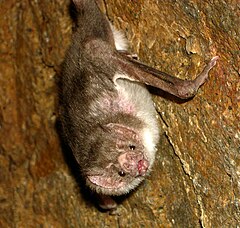チスイコウモリ亜科
| チスイコウモリ亜科 | ||||||||||||||||||||||||
|---|---|---|---|---|---|---|---|---|---|---|---|---|---|---|---|---|---|---|---|---|---|---|---|---|
 ナミチスイコウモリ (Desmodus rotundus)
| ||||||||||||||||||||||||
| 分類 | ||||||||||||||||||||||||
| ||||||||||||||||||||||||
| 学名 | ||||||||||||||||||||||||
| Desmodontidae Bonaparte, 1845 | ||||||||||||||||||||||||
| 英名 | ||||||||||||||||||||||||
| Vampire bat | ||||||||||||||||||||||||
| 属 | ||||||||||||||||||||||||
|
チスイコウモリ亜科 (Desmodontinae) は中南米に生息するヘラコウモリ科の亜科である。エサとして血を補給する行動はヘマトファジーと呼ばれる。現在、3種が存在している。
分類
かつてはチスイコウモリ亜科は独立の科に分類されていたが、現在では3種の現存種がヘラコウモリ科中の亜科として分類されている[1]。
ヘラコウモリ科の中では、現存3種は他のヘラコウモリ科の種より類似した特徴を持つ。このためヘマトファジーを行うようになった種が他種から分化し、その後この種を祖とする3種が分化したと考えられている[1]:163–167。
Gray(1825)の分類によれば、チスイコウモリ亜科には3属3種が存在する[2]。(和名は川田ほか(2018)による[3]。)
- チスイコウモリ亜科 Desmodontinae
進化
ヘラコウモリ科には蜜食の種、花粉食の種、昆虫食の種、果実食の種、肉食の種がいる[1]。 だが、チスイコウモリ亜科の3種はヘラコウモリ科の種どころか哺乳類全体でも、専ら吸血により給餌する(ヘマトファジーを行う)ように進化した[6][7]。 ヘマトファジーに適した進化をするためには、大量の液体が排出器官を圧迫すること[8]、鉄中毒[9]、過剰なタンパク質の処理方法[10]に関する問題を克服する進化を遂げなければならないことから、珍しい進化をしている。 以下では、チスイコウモリ亜科の進化に関するいくつかの仮説をあげる。
- 果実の皮をむくことに適応した鋭い歯を持つ果実食のコウモリから進化した説[11]
- もともと大型動物の外部寄生虫を食べていたコウモリが次第に吸血するようになった説[12]
- もともとは動物の傷口に付いた昆虫を食べていたコウモリが次第に吸血するようになった説[13]
- もともとは樹上の脊椎動物を捕食していた説[14]
- 樹上の雑食性コウモリがより大型の動物の血肉を動物の傷口から摂取するようになった説[15]
- 蜜食のコウモリが異なる種類の液体を摂取するようになった説[16]
チスイコウモリ亜科の祖先はおよそ2,600万年前に他のヘラコウモリ科の種から分かれたとされる[17]。さらにhairy-legged vampire batは鳥の血を吸血しているという特徴から亜科の他の2種から2,170万年前に分化したと推定されている[17]。 2012年の報告では昆虫食を行うようになったコウモリから派生した説を有力視している[17]。400万年以内に吸血に適応するように他のヘラコウモリ科から分化しており、哺乳類では最も早い自然選択の例として知られている[17]。
解剖生理学

果実食性のコウモリとは異なり、チスイコウモリは円錐形の短い鼻口部を持つ。鼻葉を持たず、鼻の先端部にはU字型の溝があるパッドがついている。ナミチスイコウモリは鼻で獲物の皮膚近くに流れている血液の熱を感知している[18]。チスイコウモリの脳内には、ヘビにおけるピット器官と組織学的に同様の役割がある器官が存在する[19][20]。
チスイコウモリは噛みちぎるための前歯が発達し、奥歯は他のコウモリより小さくなっている。チスイコウモリの脳のうち、音を処理する下丘は、吸血を行う動物の寝息を検知することに適している[21][22]。
チスイコウモリは他のコウモリとは違い陸上を歩いたり、跳躍したり、走ったりすることができるが、脚よりも翼の方がはるかに強力であるため、後肢ではなく前肢を使って力を生み出す独特の跳ねる歩行を行う。この歩行能力はチスイコウモリが進化に伴い独自に発達させたものである[23]。
宿主のゲノムに自分の遺伝子のコピーを入れる内在性レトロウイルスと呼ばれる血液感染性のウイルス群に対して高い耐性を持つ。[24]。
脚注
- ^ a b c Wetterer, Andrea L.; Rockman, Matthew V.; Simmons, Nancy B. (2000). “Phylogeny of phyllostomid bats (Mammalia: Chiroptera): data from diverse morphological systems, sex chromosomes, and restriction sites.”. Bull. Am. Mus. Nat. Hist. 248: 1–200. doi:10.1206/0003-0090(2000)248<0001:popbmc>2.0.co;2. hdl:2246/1595.
- ^ Simmons, N.B. (2005). "Order Chiroptera". In Wilson, D.E.; Reeder, D.M (eds.). Mammal Species of the World: A Taxonomic and Geographic Reference (3rd ed.). Johns Hopkins University Press. pp. 312–529. ISBN 978-0-8018-8221-0. OCLC 62265494。
- ^ 川田伸一郎他 「世界哺乳類標準和名目録」『哺乳類科学』第58巻 別冊、日本哺乳類学会、2018年、1 - 53頁。
- ^ “Fossilworks: Desmodus”. fossilworks.org. 27 May 2019閲覧。
- ^ Suárez, W (2005). “Taxonomic status of the Cuban vampire bat (Chiroptera: Phyllostomidae: Desmodontinae: Desmodus)”. Caribbean Journal of Science 41 (4): 761–767.
- ^ Botero-Castro, Fidel; Tilak, Marie-Ka; Justy, Fabienne; Catzeflis, Francois; Delsuc, Frédéric; Douzery, Emmanuel J.P. (2018). “In cold blood: Compositional Bias and Positive Selection Drive the High Evolutionary Rate of Vampire Bats Mitochondrial Genomes”. Genome Biology and Evolution 10 (9): 2218–2239. doi:10.1093/gbe/evy120. PMC 6127110. PMID 29931241.
- ^ Poulin, Robert; Randhawa, Haseeb S. (February 2015). “Evolution of parasitism along convergent lines: from ecology to genomics”. Parasitology 142 (Suppl 1): S6–S15. doi:10.1017/S0031182013001674. PMC 4413784. PMID 24229807.
- ^ Breidenstein C. P. (1982). “Digestion and assimilation of bovine blood by a vampire bat (Desmodus rotundus)”. Journal of Mammalogy 63 (3): 482–484. doi:10.2307/1380446. JSTOR 1380446.
- ^ Morton D., Wimsatt W. A. (1980). “Distribution of iron in the gastrointestinal tract of the common vampire bat: Evidence for macrophage‐linked iron clearance”. The Anatomical Record 198 (2): 183–192. doi:10.1002/ar.1091980206. PMID 7212303.
- ^ Singer M. A. (2002). “Vampire bat, shrew, and bear: comparative physiology and chronic renal failure”. American Journal of Physiology. Regulatory, Integrative and Comparative Physiology 282 (6): R1583–R1592. doi:10.1152/ajpregu.00711.2001. PMID 12010738.
- ^ Slaughter, B. H. (1970). “Evolutionary trends of chiropteran dentitions”. About Bats. Dallas: Southern Methodist University Press. pp. 51–83
- ^ Gillette, D. D. 1975. Evolution of feeding strategies in bats. Tebiwa 18: 39–48
- ^ Fenton M. B. (1992). “Wounds and the origin of blood‐feeding in bats”. Biological Journal of the Linnean Society 47 (2): 161–171. doi:10.1111/j.1095-8312.1992.tb00662.x.
- ^ Sazima I (1978). “Vertebrates as food items of the woolly false vampire, Chrotopterus auritus”. Journal of Mammalogy 59 (3): 617–618. doi:10.2307/1380238. JSTOR 1380238.
- ^ Schutt, W. A., Jr. 1998. Chiropteran hindlimb morphology and the origin of blood-feeding in bats. In T. H. Kunz, and P. A. Racey (eds.), Bat biology and conservation: 157–168. Washington D.C.: Smithsonian Inst.
- ^ Baker, Robert J.; Carter, Dilford C.; Jones, J. Knox. (1976). Biology of bats of the New World family Phyllostomatidae /. doi:10.5962/bhl.title.142603.
- ^ a b c d Baker, R. J.; Bininda-Emonds, O. R.; Mantilla-Meluk, H.; Porter, C. A.; Van Den Bussche, R. A. (2012). “Molecular timescale of diversification of feeding strategy and morphology in New World leaf-nosed bats (Phyllostomidae): a phylogenetic perspective”. Evolutionary history of bats: fossils, molecules and morphology. pp. 385–409
- ^ Ludwig Kürten; Uwe Schmidt; Klaus Schäfer (1984). “Warm and Cold Receptors in the Nose of the Vampire Bat Desmodus rotundus.”. Naturwissenschaften 71 (6): 327–328. Bibcode: 1984NW.....71..327K. doi:10.1007/BF00396621. PMID 6472483.
- ^ Angela L. Campbell, Rajesh R. Naik, Laura Sowards and Morley O. Stone (2002). “Biological infrared imaging and sensing”. Micron 33 (2): 211–225. doi:10.1016/S0968-4328(01)00010-5. PMID 11567889. オリジナルの2003-06-15時点におけるアーカイブ。.
- ^ *Kishida, R; Goris, RC; Terashima, S; Dubbeldam, JL. (1984). “A suspected infrared-recipient nucleus in the brainstem of the vampire bat, Desmodus rotundus”. Brain Res. 322 (2): 351–355. doi:10.1016/0006-8993(84)90132-X. PMID 6509324.
- ^ Uwe Schmidt, Peter A. Schlegel, Hermann Schweizer and Gerhard Neuweiler (1991). “Audition in vampire bats, Desmodus rotundus”. J Comp Physiol 168: 45–51. doi:10.1007/bf00217102.
- ^ Udo Gröger & Lutz Wiegrebe (2006). “Classification of human breathing sounds by the common vampire bat, Desmodus rotundus”. BMC Biology 4: 18. doi:10.1186/1741-7007-4-18. PMC 1513255. PMID 16780579.
- ^ Riskin, Daniel K. and John W. Hermanson. 2005. Biomechanics: Independent evolution of running in vampire bats. Nature 434: 292–292. Abstract, video. Archived September 23, 2005, at the Wayback Machine.
- ^ “Vampire Bats Survive by Only Eating Blood—Now We Know How”. (2018年2月22日) 2018年11月10日閲覧。
